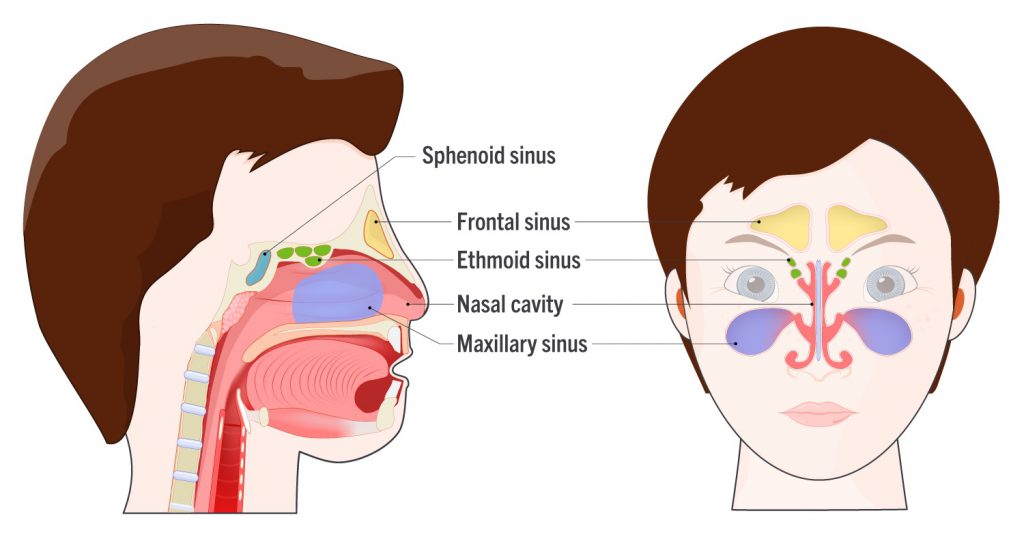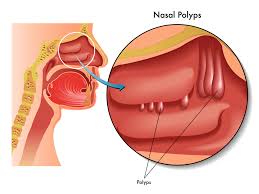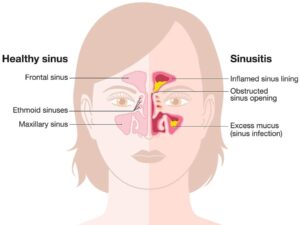

In today’s digital era, the extended use of computers, smartphones, and other electronic devices has led to a widespread postural problem commonly known as “nerd neck” or forward head posture.
This condition occurs when the head protrudes in front of the shoulders, placing excessive strain on the neck and upper back muscles.
As per BestForwardheadPostureFix, “While many are aware of its association with chronic neck pain, tension headaches, and shoulder discomfort, fewer people realize the significant impact this posture can have on sinus health.”
Forward head posture can restrict proper alignment of the cervical spine, which in turn may compromise the function of the lymphatic and venous systems responsible for draining the sinuses.
Poor posture can lead to compression of nasal passage, reduced sinus drainage, and even contribute to chronic sinus infections or pressure.
This article delves into the lesser-known link between forward head posture and sinus drainage, while also providing practical, posture-correcting strategies to help alleviate this issue.
Index
- Understanding Nerd Neck and Its Causes
- The Anatomy of Sinuses and Their Drainage Mechanism
- How Forward Head Posture Affects Sinus Drainage
- The Role of Cervical Spine Alignment in Sinus Health
- Symptoms Indicating Sinus Drainage Issues Due to Poor Posture
- Effective Exercises to Correct Nerd Neck and Improve Sinus Drainage
- Chiropractic Interventions for Posture Correction and Sinus Relief
- FAQs on Sinus Drainage and Forward Head Posture
- Lifestyle Modifications to Prevent Nerd Neck and Promote Sinus Health
Understanding Nerd Neck and Its Causes
Nerd neck, medically known as forward head posture, describes a condition in which the head juts forward out of its natural alignment with the cervical spine.
Instead of resting directly above the shoulders, the head shifts forward, placing increased stress on the neck and upper back.
This misalignment commonly develops due to prolonged use of electronic devices such as smartphones and computers, poor workstation ergonomics, and a general lack of postural awareness during everyday tasks like reading, driving, or sitting for extended periods.
As this posture becomes habitual, it can lead to a range of physical issues, including muscle imbalances, chronic tension, joint strain, and decreased mobility in the neck and upper back.
Left uncorrected, forward head posture may contribute to headaches, nerve compression, and even breathing difficulties, making early awareness and intervention crucial for long-term musculoskeletal health.
The Anatomy of Sinuses and Their Drainage Mechanism
The human skull contains four pairs of sinuses, which are air-filled cavities that play a vital role in respiratory health and immune defense.
These include:
• Frontal Sinuses – located in the forehead, just above the eyebrows.
• Ethmoid Sinuses – positioned between the eyes, within the ethmoid bone.
• Maxillary Sinuses – the largest of the sinuses, found within the cheekbones.
• Sphenoid Sinuses – situated deeper in the skull, behind the eyes and near the center of the head.
These sinuses are lined with mucous membranes that produce mucus to keep the nasal passages moist and help trap dust, pollutants, and pathogens.
For optimal function, this mucus must drain efficiently into the nasal cavity. When sinus drainage is impaired—due to infection, inflammation, or poor posture—mucus can build up, leading to restricted nasal airflow, congestion, pressure, and potential sinus infections.
Maintaining proper posture and sinus health is essential to supporting this natural drainage process.
How Forward Head Posture Affects Sinus Drainage?
Maintaining proper neck alignment is essential for effective sinus drainage and overall sinus health.
The cervical spine naturally has a gentle curve that helps keep the head balanced and the airway and sinus drainage pathways unobstructed.
This alignment allows gravity and normal physiological processes to assist in moving mucus from the sinuses into the nasal cavity, where it can be cleared.
However, when the head consistently juts forward—such as during prolonged smartphone use or slouching at a desk—this natural curvature becomes flattened or reversed.
As a result, the tissues around the sinuses may become compressed or restricted, impeding normal mucus flow.
For example, someone who spends hours hunched over a laptop may experience chronic sinus congestion not because of allergies or illness, but due to poor neck posture.
Over time, this stagnation of mucus can increase sinus pressure, promote bacterial growth, and raise the risk of frequent sinus infections and discomfort.
The Role of Cervical Spine Alignment in Sinus Health
The upper cervical spine, especially the first two vertebrae—the atlas (C1) and axis (C2)—plays a critical role in supporting the weight of the head, allowing for a wide range of motion, and protecting the brainstem and spinal cord as they pass through this region.
These vertebrae are intricately connected to the nervous system, including cranial nerves and autonomic pathways that influence sinus function.
Misalignments or subluxations in this area can disrupt normal nerve signaling and reduce the efficiency of sinus drainage by affecting the vasomotor control of mucosal blood vessels and glandular secretions within the sinuses.
This can lead to increased mucus retention, sinus pressure, and inflammation.
Basically your forward head tilt damages your nostrils.
Studies in chiropractic and osteopathic literature suggest that restoring proper alignment to the atlas and axis may improve sinus drainage and reduce symptoms of sinus congestion or infection (See: Degenhardt et al., Journal of Bodywork and Movement Therapies, 2007; Henderson, Chiropractic & Osteopathy, 2010).
Addressing upper cervical misalignments through posture correction or manual therapy may therefore enhance sinus function and alleviate related discomfort naturally.
Symptoms Indicating Sinus Drainage Issues Due to Poor Posture
Individuals with forward head posture may experience a range of symptoms that go beyond neck and shoulder discomfort, potentially affecting their sinus health and overall well-being.
Common sinus-related issues linked to this posture include:
- Chronic Nasal Congestion – A constant feeling of nasal stuffiness, often without clear triggers such as allergies or colds, may result from impaired sinus drainage due to postural misalignment.
• Frequent Sinus Infections – Poor posture can cause mucus to stagnate in the sinuses, creating a breeding ground for bacteria and leading to repeated episodes of sinusitis.
• Headaches – Pain localized in the forehead, around the eyes, or at the base of the skull can stem from both sinus pressure and muscle tension caused by forward head posture.
• Facial Pressure – A sensation of fullness or tightness in the cheeks, nose, or brow may develop as sinus pathways become obstructed.
• Postnasal Drip – Excess mucus can accumulate in the throat when it cannot drain properly from the sinuses.
Recognizing these symptoms as potentially posture-related can empower individuals to correct alignment issues and reduce sinus-related discomfort.
Effective Exercises to Correct Nerd Neck and Improve Sinus Drainage
Incorporating specific exercises can help realign the cervical spine and promote better sinus drainage:
- Chin Tucks: While sitting or standing upright, gently retract the chin inward, creating a “double chin” without tilting the head. Hold for a few seconds and repeat several times.
- Chest Openers: Clasp the hands behind the back and gently lift them upward to stretch the chest and counteract the forward pull of the shoulders.
- Neck Stretches: Tilt the head sideways, bringing the ear toward the shoulder, to stretch the side muscles of the neck.
Consistent practice of these exercises can strengthen neck muscles and restore natural posture.
Chiropractic Interventions for Posture Correction and Sinus Relief
Listed below are a ways how a chiropractic can assist an individual with a forward neck:
- Focus on Spinal Alignment: Chiropractic care is dedicated to diagnosing, treating, and preventing musculoskeletal disorders, with a primary emphasis on proper spinal alignment and optimal nervous system function.
- Addressing Forward Head Posture: Chiropractors frequently treat forward head posture, a condition that places excessive strain on the neck and upper back, disrupts the natural spinal curve, and may impair nerve communication.
- Restoring Proper Alignment: Through targeted spinal adjustments—especially in the cervical region—chiropractic care helps restore proper alignment, which can reduce muscle tension and alleviate nerve interference that might affect sinus drainage.
- Techniques for Sinus Relief: Certain chiropractic methods, such as sinus release and cranial adjustments, are specifically designed to enhance sinus drainage. These techniques work by relieving pressure and promoting the natural flow of mucus.
- Reducing Sinus-Related Symptoms: By correcting posture and improving drainage, chiropractic treatment can help lessen symptoms like facial pressure, postnasal drip, and chronic congestion.
- Personalized Care: Consulting with a qualified chiropractor offers a tailored approach, combining postural correction with targeted sinus relief strategies to improve overall respiratory and musculoskeletal health.
Lifestyle Modifications to Prevent Nerd Neck and Promote Sinus Health
Preventing forward head posture involves adopting ergonomic and lifestyle changes:
- Ergonomic Workstations: Ensure that computer screens are at eye level and chairs support an upright posture.
- Regular Breaks: Take frequent breaks from screen time to stretch and reset posture.
- Mindful Posture: Be conscious of head and neck alignment during daily activities, including smartphone use.
- Physical Activity: Engage in regular exercise to strengthen postural muscles and enhance overall musculoskeletal health.
Implementing these modifications can reduce the risk of developing nerd neck and its associated complications.
FAQs on Sinus Drainage and Forward Head Posture
Q-1: Can “nerd neck” (forward head posture) actually change how well my nose drains?
A-1: Yes—posture can influence nasal airflow. When the head juts forward, the upper airway angle shifts, tongue and soft-tissue tension increase, and ribcage mechanics stiffen. That combination can raise nasal resistance and make the nose feel “stuffier,” especially when you slump at a desk or lie down after screen time. Small posture tweaks—neutral head, tall chest, light chin tuck—often make nasal breathing feel easier within minutes.
Q-2: Could forward head posture affect ear pressure or Eustachian tube drainage linked to “sinus” pressure?
A-2: It can. Forward head posture changes the pull on muscles around the jaw and soft palate that help the Eustachian tube open. If that opening is inefficient, you may notice ear fullness, popping, or pressure that’s easy to mislabel as “sinus.” Gentle nasal breathing, swallowing, jaw relaxation, and neutral neck alignment support better tube mechanics and may reduce that heavy, clogged sensation.
Q-3: Do tight neck muscles from nerd neck mimic or worsen “sinus” symptoms?
A-3: Absolutely. Trigger points in the sternocleidomastoid and suboccipitals can refer pain to the forehead, cheeks, and behind the eyes—classic “sinus” zones. This isn’t true mucus blockage; it is muscle-referred pain. If a warm shower, self-massage, or posture reset eases your “sinus” ache quickly, that’s a clue the neck is involved. Add micro-breaks, gentle chin tucks, and thoracic extensions to calm these hotspots.
Q-4: Is there a link between mouth-breathing or allergic rhinitis, forward head posture, and drainage issues?
A-4: Mouth-breathing and chronic nasal irritation nudge the head forward to keep airflow comfortable. Over time, that compensatory posture can become habitual, sustaining higher nasal resistance and a sense of poor drainage. Address both pieces: manage nasal inflammation (saline rinses, allergen control, clinician-guided therapy) and retrain posture with ergonomic screen height, nose-first breathing drills, and short, frequent posture resets.
Q-5: Can posture correction meaningfully help nose or ear drainage?
A-5: Direct studies on “sinus drainage” are scarce, but the fundamentals line up: better cervical alignment reduces muscle tension, improves ribcage movement, and supports nasal breathing mechanics. Practical stack: elevate your screen to eye level, sit tall on your sit-bones, perform 5–6 gentle chin tucks hourly, add two sets of thoracic extensions daily, and practice slow nasal breathing. Combine this with medical care for rhinitis or ear concerns for best results.
Conclusion
The powerful connection between forward head posture and impaired sinus drainage highlights how deeply posture influences overall health and well-being.
What may seem like a simple habit—hunching over a phone or computer—can disrupt spinal alignment, hinder sinus function, and contribute to chronic discomfort.
Recognizing this relationship empowers individuals to take meaningful action.
By correcting forward head posture through intentional lifestyle changes, posture-conscious habits, and targeted exercises, it’s possible to restore proper alignment and promote natural sinus drainage.
For those experiencing persistent symptoms, professional care—such as chiropractic or physical therapy—can offer tailored solutions that address both the root cause and its effects.
Investing in posture health is not just about avoiding pain; it is about enhancing daily comfort, respiratory efficiency, and long-term wellness.
In today’s tech-driven world, where poor posture is increasingly common, making posture a priority could be the key to unlocking clearer sinuses and a healthier, more balanced body.
References:

